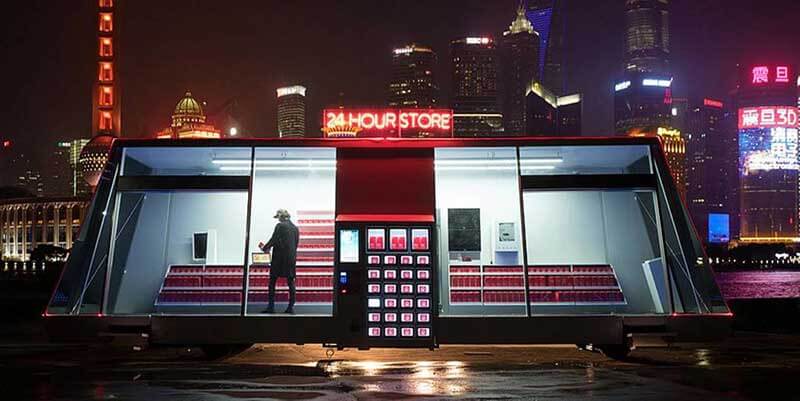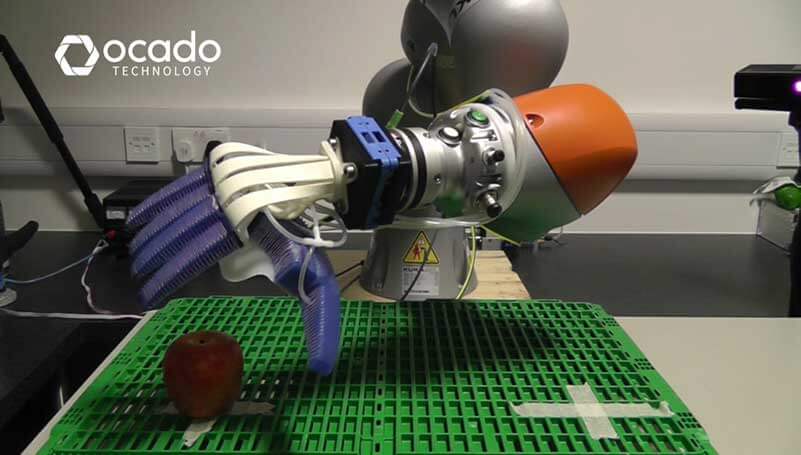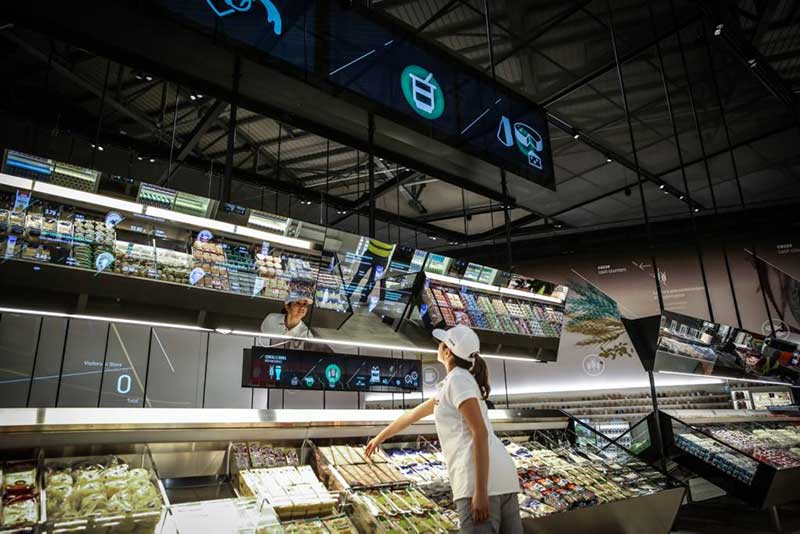- Self-driving Moby-Mart store coming to a village near you
- Amazon Go is turning science fiction-type supermarkets into a reality
- Set it, press it, get it – the Amazon Dash button is no April Fools’ joke
- Online grocery retailer is turning to robotics and machine-learned preferences
- Coop supermarket with a tech twist now operational in Milan
- The supermarket of the future will merge the digital and physical worlds
In the supermarket of the future, we will no longer stand in queues at checkout counters. We will likely only continue shopping at physical supermarkets that offer extreme levels of convenience or do so simply for the ‘experience’. The supermarket of the future will be a combination of the physical and digital world where wearables, robotics, self-driving technology, hyper-connectivity, VR and AR will play a major role.
Self-driving Moby-Mart store coming to a village near you
The 24-hour Moby-Mart convenience store has no staff and no checkout registers. The mini supermarket is designed to drive itself autonomously to a customer for a delivery or to a warehouse to replenish its stock. The Sweden-based startup, Wheelys, is developing the supermarket, in collaboration with China’s Hefei University, which focuses on the tech inside the Moby-Mart. Tomas Mazetti – a Swedish activist, inventor, founder of the invention lab Nordic Society for Invention and Discovery and co-founder of Wheelys – believes that the Moby-Mart concept is the supermarket of the future. Since it’s far cheaper to build and operate than a typical supermarket, it could help bring groceries to remote, rural areas where people don’t always have access to stores.
The Moby-Mart is unstaffed and customers use an app to gain access to the products inside, where they are greeted and assisted by a hologram-type artificial intelligence. The solar panels on top of the vehicle power the vehicle’s electric motor as well as the lighting and equipment inside. The tiny store stocks daily supplies and fresh food, but the customer can also order special products from the artificial intelligent assistant. The customer scans the products or places them in a smart basket that keeps track of the items. When done, the customer simply walks out and the store automatically charges the customer’s card. The store is designed to auto-replenish its stock. Within a city, one Moby could autonomously drive to a warehouse to get new stock, while another Moby takes its place, or Mobys could replenish each other. As soon as self-driving vehicles are allowed on roads, the Moby could autonomously find its way to the customer’s home, and for small deliveries, the company is also testing drones. The mini supermarkets could, for instance, also be purchased by groups of people, like families or villages. The Mobys are expected to be ready for franchising sometime in 2018.

Amazon Go: turning science fiction-type supermarkets into a reality
We’ve written about Amazon Go in a previous article, but being a supermarket of the future, we felt it important to mention them again. Amazon is really turning science fiction-type supermarkets into a reality. At the Seattle-based Amazon Go convenience store, customers never have to wait in line. When they enter the store, they identify themselves via an Amazon app that they scan on a sensor. Then they simply start adding groceries to their virtual shopping cart system. When done, they leave the store and their Amazon account is automatically debited. This high tech shopping experience is possible thanks to a system of computer vision, sensor fusion and deep learning, which keeps track of what is taken off the convenience store shelves. Although the Seattle branch has still not opened its doors to the public yet, Amazon appears to be preparing to bring the convenience stores to Europe as well. In the UK, they have already filed trademark applications for the slogans “No Queue, No Checkout. (No, seriously),” and “No Lines, No Checkout. (No, Seriously).”
Set it, press it, get it – the Amazon Dash button is no April Fools’ joke
Amazon is also making online shopping increasingly convenient. Now, you don’t even have to be on your computer to place an order. We’re talking about Amazon’s Dash buttons – physical hardware that enables the customer to order common household products such as toilet paper, pet supplies, cleaning products and groceries. The Dash button is a small battery-operated device no bigger than a packet of chewing gum, each one corresponding with a particular product. When you press the button, your order is automatically sent to Amazon, via Wi-Fi. With a self-adhesive strip, the buttons can be placed in your bathroom (for, let’s say toilet paper), in your laundry room (for detergent), in your kitchen, bedroom, pantry or anywhere else. Each press of a button also sends a notification to your smartphone, and if it’s pressed by mistake, the customer has half an hour to cancel the order. An indicator on the button turns green when the order was successful or red when it wasn’t. In addition to the buttons, Amazon also offers a Dash Wand, a device that lets you create a digital shopping list. You can either scan a product barcode with it or capture a spoken order by saying the product name. Selected products are then added to your Amazon shopping cart.
Online grocery retailer is turning to robotics and machine-learned preferences
The world’s largest online supermarket, Ocado – which also operates various brick-and-mortar stores – uses artificial intelligence and robots to deliver groceries to their customers. The company’s third warehouse, based in London, is currently being designed and built from scratch. The football field-sized main floor of the warehouse is divided into 1m2 sections. Underneath each section is a stack of crates filled with products. On the surface are a whopping 1,000 robots that work in a swarm. They receive orders via a 4G network, lift up the appropriate crates, scuttle around and pass each other within centimetres while taking the crates to pickers who take out the required products.
The company makes use of machine learning technology, making it possible to fill a basket with products based on learned customer preferences. The tech can even suggest healthier product options. Ocado eventually wants to harvest consumer data from smart fridges or use artificially intelligent assistants such as Alexa to listen when you talk about recipes, or check your calendar to find information on when you have people over for dinner – all in order to be able to recommend products. The ultimate goal is to have groceries appear – at exactly the right time – without the customer having to ask for them.

Coop supermarket with a tech twist now operational in Milan
Amazon Go is not the only supermarket of the future. The Italian grocer, Coop, in collaboration with Carlo Ratti, the MIT professor who founded Senseable City Lab, created a supermarket with a tech twist. And it’s already open for business at the Future Food Pavillion in Milan. The high tech grocery store is unlike anything anyone has seen before, both in terms of its layout as well as in the way technology is integrated. Instead of products simply being stacked on shelves or placed in wire baskets, they are actually meticulously curated, and all kinds of information about an item is catalogued. A customer can hold an item – such as a head of lettuce or a banana – up toward a digital screen mirror, where the item is identified and all of its important facts revealed. Not just pricing and special offers, but also information about where the item was grown and harvested, its nutritional information, allergens and even the product’s carbon footprint. And it’s not a boring, static display either. Thanks to Xbox Kinect technology, the information is educational and interactive, and customers can simply point to get more information.
The refrigerated sections in the supermarket feature digital signage, encouraging customers to read product information before opening the fridge, leading to substantial energy savings. With technology being a central component in this futuristic supermarket, there are also lots of opportunities to gather and crunch customer information about habits and preferences. This enables the supermarket to provide the right customers with the right products at the right time. As the orders flow in, robots on site sort and pack the groceries. This enables the supermarket to keep the number of items on display to a minimum and reduce waste. The Milan store is the only supermarket of its kind in the world at present, but Ratti is planning to expand the futuristic concept to other countries as well.

The supermarket of the future will probably merge the digital and physical worlds
Although some experts say that futuristic supermarket concepts like Amazon Go might be nothing more than a fad that will, in time, lose their lustre, countless research studies indicate that convenience is one of the main drivers of consumer demand. The technological advancement of these types of stores could streamline the shopping experience in such a way that customers may happily abandon traditional supermarkets altogether. Because the online shopping experience will keep improving and the digital world is developing at breakneck speed, it will be increasingly challenging for brick-and-mortar stores to remain relevant in the future. In grocery retailing, however, physical stores will always have a place – think customer service, impulse purchases and instant gratification. The supermarket of the future will probably merge the digital and physical worlds, creating a more immersive experience and offering opportunities for unique events where fresh food and new products can be discovered and tasted.
Share via:


